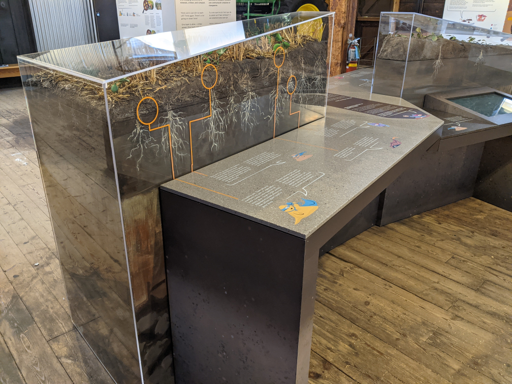By Nadine Dagenais-Dessaints, Carolyn Holland, and Erin Poulton
Abstract
This article is based on segments of Taming the Intangible; a presentation delivered at Interpretation Canada’s annual conference in September 2021. It presents strategies for supporting visitors as they explore unseen processes or theoretical concepts, sharing recent techniques from the Canada Aviation and Space Museum, the Canada Agriculture and Food Museum, and the Canada Science and Technology Museum.
Article

A living display delves below the surface, quite literally, in Soil Superheroes.
(Credit: Canada Agriculture and Food Museum)
Intangible topics can be some of the most rewarding to interpret. Subject matter that is inherently “hidden,” such as technical systems and biological cycles, is ripe with opportunities to harness visitors’ curiosity. Fun can quickly turn to frustration, though, if visitors don’t receive the support they need to make meaning. People often rely on their senses—among them sight, sound, and touch—to perceive and understand the world around them. How then do we effectively explain how residual plant material turns into soil, how an airplane is safely guided between cities, or how evolving gender biases inform domestic technologies? As the interpretive planners at Ingenium, Canada’s Museums of Science and Innovation, we often ask ourselves this very question.
As you can imagine, intangible topics are often the cornerstone of science and technology-related exhibitions. In recent years, each of our museums has planned exhibitions that challenged teams to find creative solutions that help visitors to envision, and in turn comprehend, topics that they can’t concretely see.
One initial tactic is to find a simple base principle to organize an exhibition’s structure. If your topic isn’t simple, at least your structure can be. The Canada Aviation and Space Museum’s recent exhibition Eyes on the Skies demystifies Canada’s complex air navigation system. As you can imagine, air traffic management involves a lot of unfamiliar terms, complicated equipment, and in-depth technical detail. To keep things easy for a non-expert audience to follow, the exhibition is divided into three simple sections: Systems, People, and Technologies. These relatable headings can help visitors to organize and make meaning from the information they encounter as they explore the exhibition.

Eyes on the Skies.
(Credit: Canada Aviation and Space Museum)
From there, the exhibition includes a variety of media that make intangible ideas visual. Infographics demonstrate how airliners are organized into “highways in the sky” to fly over the North Atlantic, for instance, or illustrate the different types of airspace that surround a commercial airport. Animated motion graphics explain, with a touch of whimsy, how surveillance technologies like radar are used to communicate with aircraft. Similarly, a series of vignettes emphasize the faces behind air traffic management—giving a complex topic human dimension.
Analogies can also be helpful in making complex content more cognitively accessible. Soil Superheroes, which opened in 2021 the Canada Agriculture and Food Museum, explores the fact that human life depends on the balanced interactions between the different components that make up soil. Soil is indeed a hidden world—one of the most biodiverse habitats on Earth, it not only provides us with food, fuel, and fibre, but also filtrates our water, and regulates our climate by absorbing carbon from the air. The exhibition team reimagined the message of the exhibition, presenting three superhero teams that work together to support life on land: Team Mineral, Team Critter, and Team Compost. Characters like “Wonder Worm,” “Captain Clay,” and “Number Two” appear throughout the exhibition to make complex processes, like decomposition and nutrient cycling, more tangible for young audiences.

This cow’s breakfast initiates a complex cycle!
(Credit: Canada Agriculture and Food Museum)>
In addition to a straightforward structure and clever analogies, this exhibition also uses infographics to present key ideas. One graphic, for instance, shows how the organic matter in a cow’s grassy breakfast becomes food for organisms in the soil (decomposition), helps to build good soil structure, and in turn fertilizes the growth of more grass (nutrient cycling). Poop is funny, and this exhibition leans in to the humour to hook its youngest visitors—and adults too! Storytelling techniques, in turn, engage visitors in the deeper story, while immersive videos and living dioramas provide further means for visitors to see otherwise hidden aspects of this surprising topic.
The Technology in our Lives exhibition, which debuted when the Canada Science and Technology reopened in 2017, presents a different type of hidden topic: how society and technology influence each other. By examining technologies within their social context—rather than focusing on how they work—the exhibition explores deeper meanings behind our daily interactions with technology. A wall of refrigerators, from the 1930s to present, invites visitors to consider and discuss how they have changed over time. Why are they getting larger? Why are the colours and materials changing? Advertisements and trade literature presented throughout the exhibition invite visitors to explore how gender impacts our understanding—yesterday and today—of domestic duties and their related technologies in our lives. A surprisingly simple yet rich example is a grouping of two recent near-identical Easy-bake Ovens—one is pink, while the other is black. This invites many questions about how gender roles impact children’s play and development. Similarly, cartoon images of families in one section of the exhibition reflect the current makeup of Canadian households—challenging many visitors’ unconscious biases about what constitutes a family. In this way, while the technologies on display are not inherently intangible, their underlying social impact on Canadian families—and vice versa—could go unseen if not strategically highlighted with engaging prompts throughout the exhibition.
Certainly, these are only a few of the many tools that we can all use to make intangible ideas more immediate for our visitors. Hopefully this article can help to continue the conversation about the many ways that we can support visitors as they explore “hidden” content through our exhibitions.
Nadine Dagenais-Dessaint, Carolyn Holland, and Erin Poulton are interpretive planners with Ingenium: Canada’s Museums of Science and Innovation. They have each been working in the museum field for over twenty years, with experience creating a wide range educational programs, resources, and exhibitions.